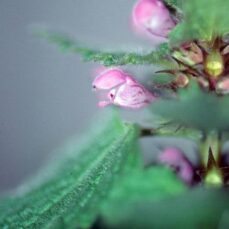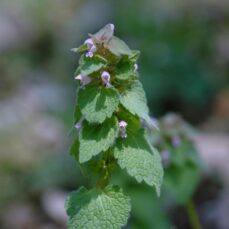
Photo credit: J. Hallworth
Management Category
Squamish
Whistler
Pemberton
Vectors of Spread
Synonyms
Red deadnettle, purple archangel, dead nettle
ID Characteristics
Flowers: The small red-purple or pink flowers are tubular, and the upper lobe is usually darker than the lower one. The upper and lower petals incline toward each other. The flowers form axillary clusters (attached at the juncture of stems and leaf stalks). They are arranged in false whorls of 3-6 flowers.
Stem: Stems are square, about 30 cm tall and bear pairs of leaves that grow opposite one another.
Leaves: The leaves don’t have stinging hairs like other nettles. They densely crowd the stem and each pair rotates 90 degrees from the pair of leaves immediately below or above. The young leaves at the apex of the stem are tinted purple and become dull green when mature.
Fruit: Purple dead-nettle flowers produce four reddish-brown nutlet seeds. Distinctive dark lines run down the centre of each nutlet face and around the outside.
Roots: The roots are shallow and fibrous.
Similar Species
Native
Self-Heal (Prunella vulgaris var. lanceolate): The leaves of self-heal may be slightly toothed or entirely round, and the leaves are not purple. The many flowers of self-heal occur in a single inflorescence above the upper leaves.

By Jesse Taylor – Own work, CC BY-SA 3.0, https://commons.wikimedia.org/w/index.php?curid=20255993
Invasive
Common dead-nettle (Lamium amplexicaule) has stemless leaves.

Common Dead-Nettle John D. Byrd, Mississippi State University, Bugwood.org
Habitat and Origin
Purple dead-nettle is native to Europe and Asia. It was introduced to North America through the horticultural trade. It now grows in southern British Columbia and eastern Canada.
Purple dead-nettle grows well in disturbed areas. It grows in areas with full sunlight or light shade and moist, fertile soil. It can be found in gardens, orchards, fields, ditches, and weedy edges of woodlands.
How It Spreads
Purple dead-nettle spreads through both seeds and vegetative methods. Flowers can self-pollinate before opening but can also be cross-pollinated by bees and wasps. Roots can form new genetically identical plants by creeping (via horizontal roots growing outwards from the main plant and sending up clones) or by forming new plants from root fragments. Purple dead-nettle can germinate year-round when buried at depths of 0.5 – 2 cm. One plant generally produces 300 seeds (but up to thousands!), which persist in the soil for several years.
Purple dead-nettle is sometimes sold for ornamental purposes, so the nursery trade and gardeners are considered the plant’s main vector of spread. Purple dead-nettle is also spread in contaminated soil and by dumping garden waste.
Impacts
Ecological:
- Outcompetes native plants by forming dense ground cover shading out native species.
- Reduces available space, nutrients and water available for other vegetation.
- Reduces biodiversity
Economic:
- Reduces crop yields.
Stop the Spread
There is insufficient information about Purple dead-nettle’s distribution, impacts, potential for spread and feasibility for control in the Sea to Sky. If you see Purple dead-nettle’s, please report it.
Learn to identify Purple dead-nettle: use the images on this profile page to learn how to identify Purple dead-nettle.
What to do if you spot it: You can report any Purple dead-nettle sighting visiting our reporting page.
DO:
- Regularly monitor properties for weed infestations.
- Ensure soil and gravel are uncontaminated before transport.
- Check wildflower mixes to ensure that they do not contain Purple Dead-Nettle.
- Ensure plants are disposed of in a garbage bag if found in floral arrangements to prevent seeds from spreading.
DO NOT:
- Do not unload, park or store equipment or vehicles in infested areas; remove plant material from any equipment, vehicles or clothing used in such areas and wash equipment and vehicles at designated cleaning sites before leaving infested areas.
- Do not plant Purple Dead-Nettle in a garden, no matter how well-contained its enclosure may seem.
- Do not move soil that has been contaminated with Purple Dead-Nettle.
- Do not compost!
Control
Mechanical
- Purple dead-nettle can be pulled up by hand before it goes to seed.
- Regular mowing/tilling will reduce weed progression, but won’t eradicate the plant.
- All plant parts must be bagged and deeply buried in a landfill; if plant fragments are left on site, Purple dead-nettle is likely to re-establish.
- When tilling, be sure to prevent machinery from spreading root fragments to new sites.
Chemical
- Purple dead-nettle can be controlled with metsulfuron.
- Fall and early spring applications are generally the most effective and may also suppress seed production.
We recommend that any herbicide application is carried out by a person holding a valid BC Pesticide Applicator Certificate. Before selecting and applying herbicides, you must review and follow herbicide labels and application rates; municipal, regional, provincial and federal laws and regulations; species-specific treatment recommendations, and site-specific goals and objectives.
Biological
There are no biocontrol agents available in BC for this plant.
Sea to Sky Distribution
Purple Dead-Nettle Factsheet
Having trouble viewing the factsheet? Don’t worry, all the information is included on this page. You can also contact us with any questions.
References
- Edible Wild Food, Purple Deadnettle
- Electronic Atlas of the Flora of BC, Lamium purpureum
- Fraser Valley Invasive Species Society, Purple Deadnettle
- Gardening Know-How, Purple Deadnettle Control: Getting Rid of Purple Deadnettle Weeds
- Illinois Wildflowers, Purple Dead Nettle
- Invasive Species Council of BC, Purple deadnettle
- Island Nature, Purple Dead-Nettle
- Michigan State University, Purple Deadnettle
- Native Plant Trust, Lamium purpureum
- Nature Gate, Red Dead-nettle
- North Carolina Extension Gardener Plant Toolbox, Lamium purpureum
- Plants For a Future, Lamium purpureum – L.
- Stewardship Centre for British Columbia, “Lamium purpureum” in Invasive Species in Garry Oak and Associated Ecosystems in British Columbia
- United States Department of Agriculture Natural Resources Conservation Service, Purple Deadnettle
- Vancouver Island Grows, Lamium purpureum













